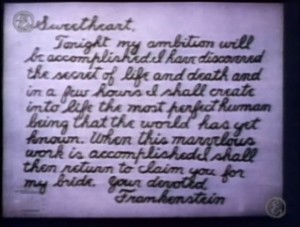Frankenstein -1910
This is going to be a short review of a strange movie. It’s the first ever film version of Mary Shelley’s novel and it’s… special. Historically, it’s much less of a big deal than the 1931 version. James Whale’s Frankenstein created much of the modern iconography of Frankenstein – the stitched together body, the slab, the lightning.

The 1910 version has none of this. It’s based to some degree on the stage tradition of Frankenstein, which often had Frankenstein create the Monster through alchemical means. This is not completely at odds with the novel, in which Victor is inspired as much by alchemical thinkers as by contemporary science. What it meant in terms of staging is that the actor playing the Monster often made his appearance springing out of a huge cauldron, and something similar happens here.
Time for a synopsis. Don’t worry, it won’t take long. Victor Frankenstein leaves his home and goes off to study. He creates a Monster by some means. The Monster torments him, mostly by standing a short distance away and making somewhat threatening gestures. It’s a silent movie, but even so somehow you can tell it’s saying ‘oogie boogie’ as it waves its hands.

Victor marries Elizabeth, but the Monster comes to terrify the couple. Frankenstein flees. Elizabeth begs him to stay. The narration informs us that ‘The creation of an evil mind is overcome by love”. The Monster sees itself in the mirror and is horrified. It vanishes, leaving its reflection. Victor looks in the mirror and sees the Monster’s reflection. Then the reflection vanishes, and Victor is looking at himself. The end.
It’s an Edison film, pre-WWI. Thought lost for many years, it was rediscovered in the 1970s. It’s public domain now and there are several versions up on YouTube. It’s fifteen minutes long, but feels much longer. Like a lot of films of its era, its set up for cool visuals rather than coherent storytelling. Actually, that’s unfair; I could say the same about a lot of films made today. But in spite of the old film’s slightness, there are a few interesting things to say about it.

Firstly, the mirror scene. Pretty much the only aspect of this movie that I’ve seen repeated in other Frankenstein films is the moment when the Monster sees itself and is horrified. Having said that, this one goes in a very different direction. This film leaves open the question of whether Frankenstein literally created a Monster or not. Did he create a being that was somehow defeated by love? Or is it some sort of Jekyll-Hyde story, with the Monster as Frankenstein’s bad side externalised?
If so, the film has a moral very different to most Frankenstein movies. The moral is, nice young man leaves his family to go away to college. As sometimes happens in these cases, away from his family’s influence, he picks up some unsavoury habits. (What habits don’t really matter. Drinking, gambling, sleeping around… pick one, they’re all good.) Ashamed of his behaviour, Frankenstein comes to see his vices as a separate person, tormenting him. He now fears he is too tainted by his bad behaviour to marry his sweetheart, but at her insistence he gets over himself, straightens up and flies right. The end.

That’s not a terrible story. But it’s not really Frankenstein, is it?
The other interesting aspect of the film is the special effects. A lot of them are just done with the technique pioneered by Georges Melie of using cuts to make characters appear or disappear. But the other interesting effect is the creation of the Monster. I’m pretty sure it was done by building a papier-mâché puppet with a wooden armature, and having someone make it move while they set it alight and filmed it burning. Then they reversed the film, making it look like ‘flesh’ was growing over ‘bones’.
Finally the Monster’s design. It’s… it’s kind of stupid looking. Again, this is a throwback to the theatrical tradition of Frankenstein, in which the Monster was designed to look grotesque, not to make any sort of sense. If the Monster represents Frankenstein’s vices, then they were probably pretty lame vices. Maybe he played his wax-cylinders too loudly, or didn’t return library books on time or something.

Or maybe this crappiness just comes from the fact that it was a pre-WWI horror. Horror movies didn’t really come into their own until after the war. After a sizeable portion of the audience had been through years of living Hell, postwar horror filmmakers really had to up their game to make films seem scary.
All in all, I’d have to describe this film as an interesting curiosity, rather than an important point in the evolution of the Frankenstein myth. It may be the first, but it’s a precedent rather than a true beginning.



